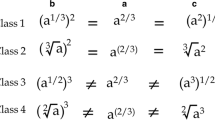Abstract
Prior studies showed that stimulus equivalence did not emerge in nonhuman and it may be what distinguish humans from non-humans. We think that stimulus equivalence is the origin of human fs illogical reasoning.
For applying neural networks to stimulu equivalence, a problem of missing input features and self-supervised learning must be solved. In this paper, we propose a neural network model based on the iterative inversion method which has a potential possibility to explain the stimulus equivalence and demonstrated the validity of the proposed model by computer simulations. Furthermore, it was discussed that the proposed model was an appropriate model of symmetry for human reasoning.
Preview
Unable to display preview. Download preview PDF.
Similar content being viewed by others
References
Sidman, M., Tailby, W.: Conditional discrimination vs. matching to sample:An expansion of the testing paradigm. Jurnal of the Experimental Analysis of Behavior 37, 5–22 (1982)
Sidman, M.: Equivalence relations and behavior: A research story. Authors Coopereative, Boston (1994)
Harlow, H.F.: The formation of learning sets. Psychological Review 56, 51–65 (1949)
Vaughan, W.: Formation of Equivalence Sets in Pigeons. Journal of Experimental Psychology, Animal Behavior Processes 14(1), 36–42 (1988)
Delius, J.D., Sieman, M.: Transitive responding in animals and humans:Explanation rather than adaptation? Behavioural Processes 42, 107–137 (1908)
Masumoto, D., Kimoto, T., Nagata, S.: A Neural Network Approach to Sensorimotor Fusion. IMACS/SICE RMS92 Kobe, 1105–1110 (1992)
Nagata, S.: Control of Mobile Robots with Neural Networks. INNS, 349 (1988)
Author information
Authors and Affiliations
Editor information
Editors and Affiliations
Rights and permissions
Copyright information
© 2005 Springer-Verlag Berlin Heidelberg
About this paper
Cite this paper
Okada, H., Sakagami, M., Yamakawa, H. (2005). Modeling Stimulus Equivalence with Multi Layered Neural Networks. In: Cabestany, J., Prieto, A., Sandoval, F. (eds) Computational Intelligence and Bioinspired Systems. IWANN 2005. Lecture Notes in Computer Science, vol 3512. Springer, Berlin, Heidelberg. https://doi.org/10.1007/11494669_20
Download citation
DOI: https://doi.org/10.1007/11494669_20
Publisher Name: Springer, Berlin, Heidelberg
Print ISBN: 978-3-540-26208-4
Online ISBN: 978-3-540-32106-4
eBook Packages: Computer ScienceComputer Science (R0)




